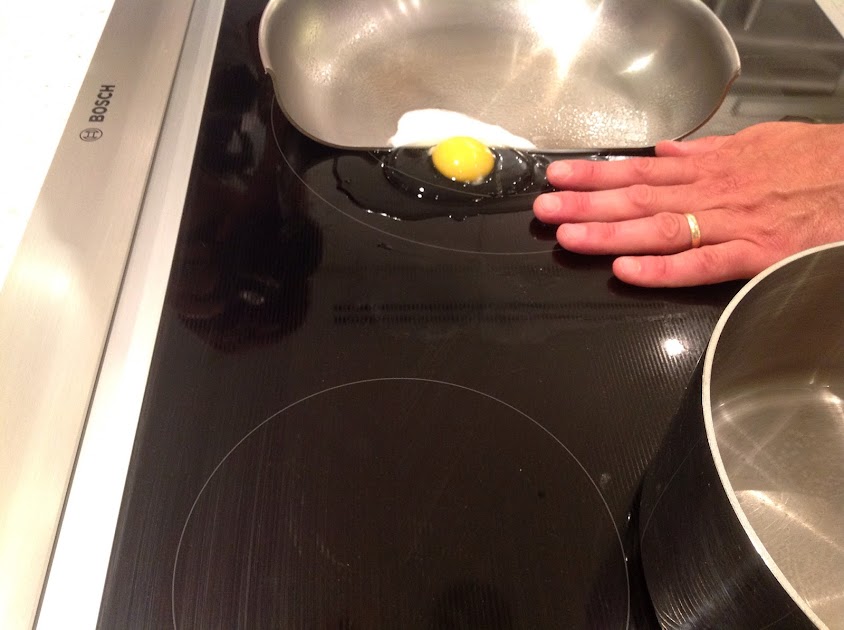Last month as part of my trip out to the Bosch Experience and Design Center in Irvine, CA I had the opportunity to learn more about induction cooking and to make a meal using one. And I must say that I am love! My last stove top was a glass top electric and I really liked the shiny, smooth surface which was easy to clean and always looked great. But, you do have to keep in mind that it may be very hot for a while after use and it's easy to forget that. With an induction cooktop, the only actual heat on the surface of the cooktop is the residual heat from the food in the pan, not the surface itself. Here is a video from Bosch explaining how it all works. A really great feature is that induction uses up to 60% less energy than gas and is every bit as adjustable, and cooks food twice as fast as electric.
And here is an egg that will cook only on the area where the pan and cooktop are in contact and how cool the surface is right next to it. Actually, this feature also speaks to how much easier it is to clean these glass tops vs those on electric cooktops. Since the induction cook top never gets very hot, spilled food doesn't bake onto the surface and can be wiped away immediately as if it were on a counter.
The sleek black cooktop which combines European design with German engineering reminds me of an iPhone or iPad surface, especially as the controls are embedded in the glass. It's no surprise though, as Apple's Steve Jobs was very influence by design work of Dieter Rams, whose " 10 principals of good design" are literally etched in the walls of the Bosch Experience center in California.
In full: Dieter Rams 10 Principals of Good Design:
- Is innovative - The possibilities for innovation are not, by any means, exhausted. Technological development is always offering new opportunities for innovative design. But innovative design always develops in tandem with innovative technology, and can never be an end in itself.
- Makes a product useful - A product is bought to be used. It has to satisfy certain criteria, not only functional, but also psychological and aesthetic. Good design emphasizes the usefulness of a product whilst disregarding anything that could possibly detract from it.
- Is aesthetic - The aesthetic quality of a product is integral to its usefulness because products are used every day and have an effect on people and their well-being. Only well-executed objects can be beautiful.
- Makes a product understandable - It clarifies the product’s structure. Better still, it can make the product clearly express its function by making use of the user's intuition. At best, it is self-explanatory.
- Is unobtrusive - Products fulfilling a purpose are like tools. They are neither decorative objects nor works of art. Their design should therefore be both neutral and restrained, to leave room for the user's self-expression.
- Is honest - It does not make a product more innovative, powerful or valuable than it really is. It does not attempt to manipulate the consumer with promises that cannot be kept.
- Is long-lasting - It avoids being fashionable and therefore never appears antiquated. Unlike fashionable design, it lasts many years – even in today's throwaway society.
- Is thorough down to the last detail - Nothing must be arbitrary or left to chance. Care and accuracy in the design process show respect towards the consumer.
- Is environmentally friendly - Design makes an important contribution to the preservation of the environment. It conserves resources and minimizes physical and visual pollution throughout the lifecycle of the product.
- Is as little design as possible - Less, but better – because it concentrates on the essential aspects, and the products are not burdened with non-essentials. Back to purity, back to simplicity.




0 comments:
Post a Comment